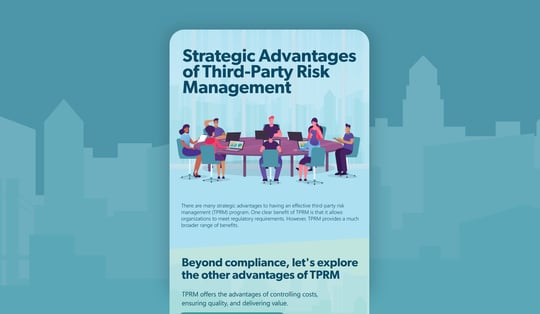Using third-party vendors is a standard business strategy that can benefit an organization in many ways. Whether it's helping to reduce costs, deliver specialized products and services to your customers or supplement existing staff, many third-party vendors have become a vital part of many business operations. Utilizing external vendors often brings rewards but isn’t without risk. To help mitigate the risk, you should have a third-party risk management program in place.
Beyond meeting regulatory requirements, when your organization has a robust third-party risk management program (TPRM), your third-party vendors can drive value as part of your overall business strategy.
Enabling Revenue and Productivity
Perhaps two of the most attractive benefits of TPRM are enabling the organization's revenue and boosting productivity, which are often accomplished in the following ways:
- Risk mitigation: It may be obvious to state, but the primary purpose of TPRM is to manage and mitigate vendor risk. Different types of risk include, but aren’t limited to, operational, financial, reputational and regulatory. Properly managing your vendors' risks helps prevent operational interruptions, protect from security threats and data breaches and is instrumental in building and protecting your organization's reputation with your customers and the public.
- Quality maintenance: Establishing service level agreements (SLAs) early in the vendor relationship helps to safeguard your organization against inferior quality products and services that don't meet your expectations. Any quality issues can quickly be identified and remedied, leaving your customers to enjoy consistent quality.
- Efficient processes: An effective TPRM program simplifies a set of interconnected practices into a repeatable process. Your organization saves valuable time and resources when processes like vendor onboarding are standardized and centralized within the TPRM program.
Reducing Costs and Rework
Cost savings is another strategic advantage of TPRM, which can primarily be accomplished by avoiding rework. Here are two strategies in which TPRM can reduce costs:
- Cost prevention: The additional costs resulting from rework, regulatory fines and litigation settlements can often be avoided through the TPRM processes of ongoing monitoring and regular risk reviews, which help identify and resolve issues before they worsen. Being proactive in managing your vendor contracts is also an effective way of preventing upcharges or price increases that may otherwise be overlooked during auto-renewals.
- Reducing rework through employee education: TPRM can bring value when used to train employees who may not have experience with vendor management. Many individuals who are skilled with vendor's products or services can often struggle with vendor management duties. TPRM can be used as the central system to train, support and advise those employees who are the first vendor owners or lines of business.
Third-party risk management can bring many strategic advantages to an organization's operations. Economically, it can reduce additional costs and help to protect your revenue. Operationally, TPRM can ensure that processes are efficient and vendor owners get the support and training they need. While regulatory compliance is often a driving factor in TPRM, don't overlook these other strategic advantages.





